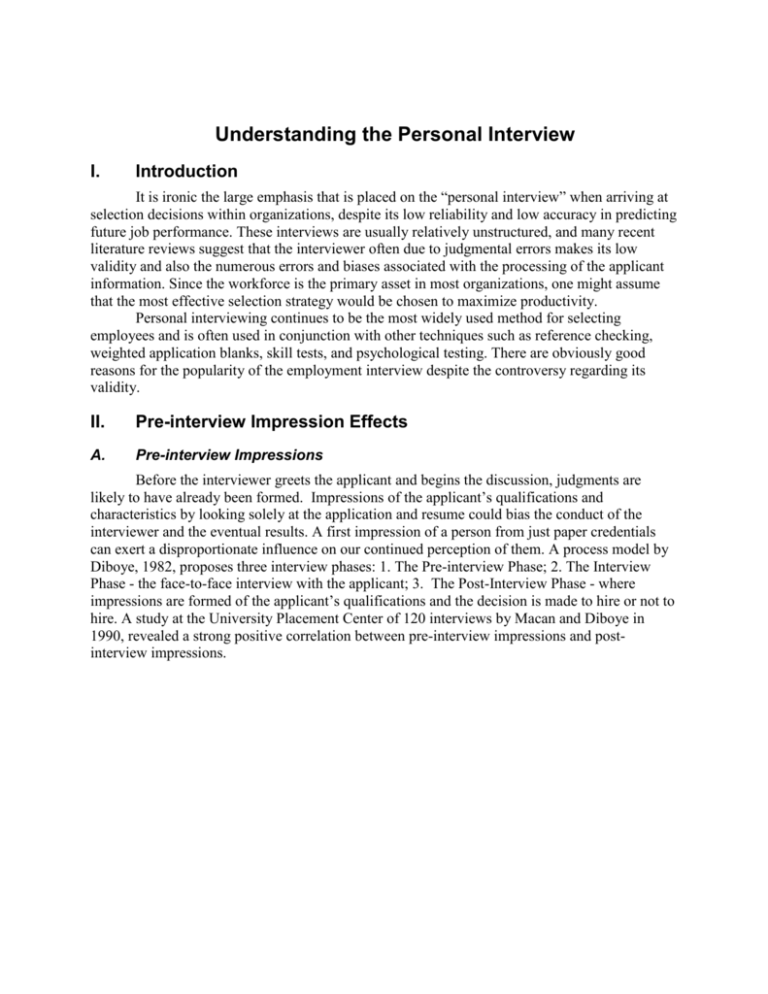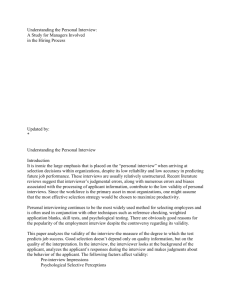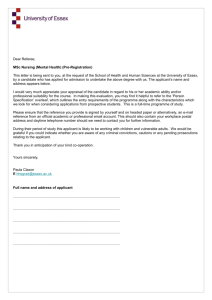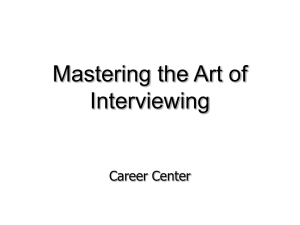Understanding the Personal Interview:
advertisement

Understanding the Personal Interview I. Introduction It is ironic the large emphasis that is placed on the “personal interview” when arriving at selection decisions within organizations, despite its low reliability and low accuracy in predicting future job performance. These interviews are usually relatively unstructured, and many recent literature reviews suggest that the interviewer often due to judgmental errors makes its low validity and also the numerous errors and biases associated with the processing of the applicant information. Since the workforce is the primary asset in most organizations, one might assume that the most effective selection strategy would be chosen to maximize productivity. Personal interviewing continues to be the most widely used method for selecting employees and is often used in conjunction with other techniques such as reference checking, weighted application blanks, skill tests, and psychological testing. There are obviously good reasons for the popularity of the employment interview despite the controversy regarding its validity. II. Pre-interview Impression Effects A. Pre-interview Impressions Before the interviewer greets the applicant and begins the discussion, judgments are likely to have already been formed. Impressions of the applicant’s qualifications and characteristics by looking solely at the application and resume could bias the conduct of the interviewer and the eventual results. A first impression of a person from just paper credentials can exert a disproportionate influence on our continued perception of them. A process model by Diboye, 1982, proposes three interview phases: 1. The Pre-interview Phase; 2. The Interview Phase - the face-to-face interview with the applicant; 3. The Post-Interview Phase - where impressions are formed of the applicant’s qualifications and the decision is made to hire or not to hire. A study at the University Placement Center of 120 interviews by Macan and Diboye in 1990, revealed a strong positive correlation between pre-interview impressions and postinterview impressions. Hakel, in 1982, concluded after his interview research that: It is abundantly clear that whatever information occurs first has disproportionate influence on the final outcome of interviews. This could be explained by the fact that people with high test scores, good grades, etc., on their credentials actually make better impressions in the interview, although studies have been done (Sparks & Manese, 1970), to show little support for this contention. B. Self-Fulfilling Prophecy An interview will form a pre-interview opinion of the applicant and will categorize them as “ideal, highly qualified” or “typical” or “unqualified,” and the interviewer’s subsequent conception of the applicant will then influence the subsequent gathering and processing of information. This “cognitive categorization,” means interviewers form expectancies of how applicants will present themselves in an interview. Macan and Diboye confirmed this theory in a study they did and found that candidates with high qualifications were expected to give better answers and display traits of an ideal candidate. Their findings also revealed that interviewers will have more favorable attitudes to these higher qualified applicants and show more signs of approval in their verbal and non-verbal behavior than the less qualified applicants. This, in turn, will influence the motivation of the applicant to make a favorable self-presentation or stop the applicant from trying to make a good impression if he becomes discouraged. Also, the interviewer can lead to a behavioral confirmation by restricting the interviewee’s responses or by only asking about negative aspects of their credentials. C. The Bias of Information Processing Disproportionate weight can be given to the pre-interview impressions for other reasons. The interviewer could either fail to recall information that is inconsistent with his expectations, or just recall information primarily which is consistent with expectations. A psychological experiment by Macon & Diboye in 1987, found that interviewers that were allowed to take notes recalled information more accurately than those who didn’t take notes. These pre-interview impressions obviously prevent interviewers from generating and retaining new information, and once they have created an impression of the candidate, they are unlikely to go out of their way to try and disprove it. III. Perception in the Interview A. The Unfavorable Information Effect There is evidence that the interviewer forms an accept/reject opinion very early on in the interview, often in the first five minutes. This could have a very adverse effect on the outcome of the interview, especially if the initial opinion is unfavorable. The results of Springbett’s research in 1958, revealed that unfavorable information had a much greater impact on selection decisions than favorable information. He found that a single early unfavorable rating resulted in a reject decision in 84% of his cases. He found that 8.8 items of favorable information were required to change an initially unfavorable impression and only 3.8 items of unfavorable information were required to alter an initially favorable impression. Since then, many other studies have been done to confirm this. A number of reasons for this have been proposed. Firstly, decision-makers almost certainly receive negative feedback about an unqualified, unsuitable candidate that has been hired, but rarely receive positive feedback about a good hiring decision. Secondly, the error of rejecting a good candidate goes unpunished. Kanouse and Hanson, offer another possible reason - that people are more motivated to avoid potential costs than look for potential rewards. In other words, a bad hiring decision is much more costly than the cost of not hiring a good applicant. B. Interviewer Decision Styles Decision styles greatly affect perception, accuracy of observation and interjudge reliability. It affects the gathering, storing, combining and evaluating of information and thus can influence the outcome of an interview. The interviewer’s decision style could change considerably in the presence or absence of stress. If something personal were at stake, nonrational feelings could distort evaluations. Thus, it might be a good idea if the interviewer simply had to describe the applicant and the information was then passed on to someone else to make the hiring decision. The interviewer’s perceptions would then be much more accurate and informative. An additional attribute that would aid in information processing is to have an interviewer with an augmented cognitive structure who can organize and hold information for a long time, and extract relevant information from speech. This will aid in the interviewer’s ability to sift through abstractions in search of clear understanding. C. Non-Verbal Communications It has already been mentioned that the interviewer often comes to a reject/accept decision in the first five minutes. In addition to this, studies reveal that nearly 100% of impressions formed in the first four minutes come from the applicant’s non-verbal behavior. Over half of a complete impression is based on just facial expressions revealing emotions such as anger or disgust and 38% of impression comes from vocal tones. Physical space, body movement, appearances, etc., are all other non-verbal clues. Since the non-verbal element is so critical, it’s important that interviewers understand the significance of non-verbal indicators and how to interpret these silent messages to make successful hiring decisions. D. Physical Characteristics An interviewer’s inferences about a candidate’s traits will not only be derived from watching their behavior, but also by observing their physical characteristics. The “halo effect” occurs when an obvious characteristic about a person influences our impressions about the person’s other characteristics. Halo effects have more impact when the characteristic is one we have a strong positive or negative feeling about. For example, the interviewer may decide the applicant is dressed inappropriately; the interviewer links this with what he believes the mode of dress means or says about the applicant. This negatively affects the interviewer’s further observations. There is evidence that physical attractiveness has an effect on interviewers’ judgment when they assess resumes of applications for managerial positions. Attractive people are presumed to have other positive qualities such as personalities, honesty, intelligence, poise and confidence. This is consistent with the “implicit personality theory” about the relationships between one trait and another. For example, a neat person is often thought of as efficient and also punctual. This means a little information can be taken a long way and also be very misleading. E. Stereotypes Interviewers are also affected by stereotypes. These are concepts that people form and that they feel they can rely on with certainty regarding the unalterable nature and character of certain types of people. Other people and friends share the same stereotypes that reinforce the interviewer’s perception and make stereotypes real. Stereotyping in an interview means that the applicant is put into a category in the interviewer’s mind. The interviewer then makes assumptions about the applicant’s character based on the traits associated with that particular category.






